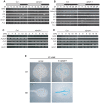Repression of FLOWERING LOCUS T chromatin by functionally redundant histone H3 lysine 4 demethylases in Arabidopsis
- PMID: 19946624
- PMCID: PMC2777508
- DOI: 10.1371/journal.pone.0008033
Repression of FLOWERING LOCUS T chromatin by functionally redundant histone H3 lysine 4 demethylases in Arabidopsis
Abstract
FLOWERING LOCUS T (FT) plays a key role as a mobile floral induction signal that initiates the floral transition. Therefore, precise control of FT expression is critical for the reproductive success of flowering plants. Coexistence of bivalent histone H3 lysine 27 trimethylation (H3K27me3) and H3K4me3 marks at the FT locus and the role of H3K27me3 as a strong FT repression mechanism in Arabidopsis have been reported. However, the role of an active mark, H3K4me3, in FT regulation has not been addressed, nor have the components affecting this mark been identified. Mutations in Arabidopsis thaliana Jumonji4 (AtJmj4) and EARLY FLOWERING6 (ELF6), two Arabidopsis genes encoding Jumonji (Jmj) family proteins, caused FT-dependent, additive early flowering correlated with increased expression of FT mRNA and increased H3K4me3 levels within FT chromatin. Purified recombinant AtJmj4 protein possesses specific demethylase activity for mono-, di-, and trimethylated H3K4. Tagged AtJmj4 and ELF6 proteins associate directly with the FT transcription initiation region, a region where the H3K4me3 levels were increased most significantly in the mutants. Thus, our study demonstrates the roles of AtJmj4 and ELF6 as H3K4 demethylases directly repressing FT chromatin and preventing precocious flowering in Arabidopsis.
Conflict of interest statement
Figures







Similar articles
-
Overexpression of a histone H3K4 demethylase, JMJ15, accelerates flowering time in Arabidopsis.Plant Cell Rep. 2012 Jul;31(7):1297-308. doi: 10.1007/s00299-012-1249-5. Epub 2012 May 4. Plant Cell Rep. 2012. PMID: 22555401
-
A plant-specific histone H3 lysine 4 demethylase represses the floral transition in Arabidopsis.Plant J. 2010 May 1;62(4):663-73. doi: 10.1111/j.1365-313X.2010.04182.x. Epub 2010 Feb 24. Plant J. 2010. PMID: 20202164
-
A companion cell-dominant and developmentally regulated H3K4 demethylase controls flowering time in Arabidopsis via the repression of FLC expression.PLoS Genet. 2012;8(4):e1002664. doi: 10.1371/journal.pgen.1002664. Epub 2012 Apr 19. PLoS Genet. 2012. PMID: 22536163 Free PMC article.
-
Control of the transition to flowering by chromatin modifications.Mol Plant. 2009 Jul;2(4):554-564. doi: 10.1093/mp/ssp005. Epub 2009 Mar 5. Mol Plant. 2009. PMID: 19825638 Review.
-
Histone demethylases and control of gene expression in plants.Cell Mol Biol (Noisy-le-grand). 2014 Dec 24;60(5):97-105. Cell Mol Biol (Noisy-le-grand). 2014. PMID: 25535719 Review.
Cited by
-
Influence of over-expression of the Flowering Promoting Factor 1 gene (FPF1) from Arabidopsis on wood formation in hybrid poplar (Populus tremula L. × P. tremuloides Michx.).Planta. 2012 Feb;235(2):359-73. doi: 10.1007/s00425-011-1507-8. Epub 2011 Sep 10. Planta. 2012. PMID: 21909761
-
Metabolic control of histone demethylase activity involved in plant response to high temperature.Plant Physiol. 2021 Apr 23;185(4):1813-1828. doi: 10.1093/plphys/kiab020. Plant Physiol. 2021. PMID: 33793949 Free PMC article.
-
Mutations in the Arabidopsis H3K4me2/3 demethylase JMJ14 suppress posttranscriptional gene silencing by decreasing transgene transcription.Plant Cell. 2012 Sep;24(9):3603-12. doi: 10.1105/tpc.112.103119. Epub 2012 Sep 21. Plant Cell. 2012. PMID: 23001035 Free PMC article.
-
Domestication and engineering of pennycress (Thlaspi arvense L.): challenges and opportunities for sustainable bio-based feedstocks.Planta. 2024 Oct 29;260(6):127. doi: 10.1007/s00425-024-04560-6. Planta. 2024. PMID: 39470818 Review.
-
Photoperiodic flowering: time measurement mechanisms in leaves.Annu Rev Plant Biol. 2015;66:441-64. doi: 10.1146/annurev-arplant-043014-115555. Epub 2014 Dec 12. Annu Rev Plant Biol. 2015. PMID: 25534513 Free PMC article. Review.
References
-
- Park DH, Somers DE, Kim YS, Choy YH, Lim HK, et al. Control of circadian rhythms and photoperiodic flowering by the Arabidopsis GIGANTEA gene. Science. 1999;285:1579–1582. - PubMed
-
- Putterill J, Robson F, Lee K, Simon R, Coupland G. The CONSTANS gene of Arabidopsis promotes flowering and encodes a protein showing similarities to zinc finger transcription factors. Cell. 1995;80:847–857. - PubMed
-
- Kobayashi Y, Kaya H, Goto K, Iwabuchi M, Araki T. A pair of related genes with antagonistic roles in mediating flowering signals. Science. 1999;286:1960–1962. - PubMed
-
- Kardailsky I, Shukla VK, Ahn JH, Dagenais N, Christensen SK, et al. Activation tagging of the floral inducer FT. Science. 1999;286:1962–1965. - PubMed
Publication types
MeSH terms
Substances
LinkOut - more resources
Full Text Sources
Other Literature Sources
Molecular Biology Databases

